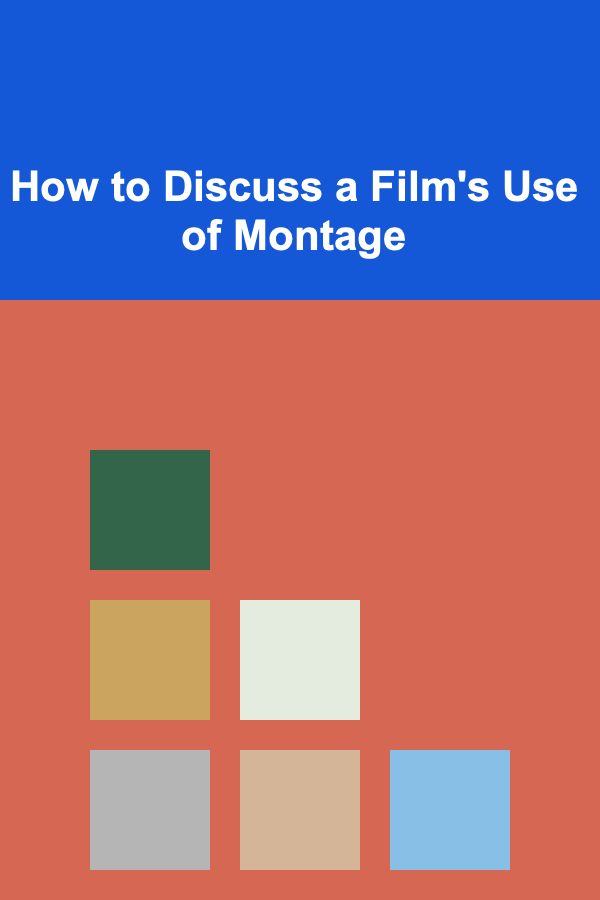
How to Discuss a Film's Use of Montage
ebook include PDF & Audio bundle (Micro Guide)
$12.99$10.99
Limited Time Offer! Order within the next:

The montage is one of the most fundamental techniques in film editing. Whether it's used to condense time, juxtapose contrasting images, or create emotional resonance, the montage serves as a powerful storytelling tool that allows filmmakers to convey a great deal of information and emotion in a condensed form. For anyone trying to analyze or discuss a film's use of montage, it's essential to understand its origins, its different types, and the critical aspects of how it's employed to enhance narrative, theme, and emotion in cinema.
In this article, we will delve into the theory, techniques, and significance of montage in film, offering insights into how to approach a discussion of this crucial cinematic device.
The Origins of Montage
Montage is a French word that translates to "assembly" or "editing." It first emerged as a distinct concept in the early years of cinema, primarily associated with Soviet filmmakers in the 1920s, notably Sergei Eisenstein. Eisenstein's works, such as Battleship Potemkin (1925), established montage as a method to create meaning through the combination of shots. For Eisenstein, the essence of montage was its ability to manipulate time, space, and meaning through editing, creating an emotional or intellectual response that couldn't be achieved through the simple continuity of narrative alone.
The Soviet Montage School
Soviet filmmakers, like Eisenstein, Dziga Vertov, and Vsevolod Pudovkin, were instrumental in developing the concept of montage into a formal technique. They viewed film editing not as a passive process of linking shots but as an active means of generating meaning. Through what Eisenstein referred to as "montage of attractions," filmmakers could force the audience to make connections between disparate images, leading to a deeper understanding of the subject matter.
For example, in Battleship Potemkin, the famous "Odessa Steps" sequence utilizes montage to create a sense of chaos and violence by juxtaposing shots of soldiers shooting civilians with shots of the terrified crowd. The rapid cutting heightens the tension and makes the viewer feel the chaos of the situation more acutely.
Montage in Hollywood
While Soviet filmmakers focused on montage as a method of intellectual engagement, Hollywood filmmakers initially used it more pragmatically---primarily to condense time, emphasize visual style, or enhance the pace of a story. Directors like D.W. Griffith, who was influenced by the pioneering work of Russian filmmakers, used montage to increase dramatic intensity or condense narrative time. The most significant difference between Soviet and Hollywood montage practices lies in the use of montage as an intellectual device versus a narrative one.
Types of Montage
Montage is a versatile tool that can take many forms depending on its purpose. Some of the most common types of montage include:
1. Metric Montage
Metric montage is based on the rhythm or timing of the cuts. In this style, shots are edited according to a predetermined number of frames, creating a rhythmic pattern that is independent of the content of the images. This can create a mechanical, almost musical effect, and is often used to convey urgency or excitement. The timing of the cuts becomes the dominant force, rather than the imagery or narrative.
A famous example of metric montage is in the Odessa Steps sequence from Battleship Potemkin, where the cutting pattern accelerates as the violence escalates, building a sense of chaos and tension.
2. Rhythmic Montage
Rhythmic montage focuses on the visual composition of the shots. The editor pays attention to the shapes, lines, and movements within the frame, aligning these elements to create a rhythmic flow between shots. This type of montage is concerned with the continuity of visual patterns across shots, rather than the time-based structure of metric montage.
For example, a filmmaker might use rhythmic montage to transition between two contrasting settings---such as a bustling city street and a quiet countryside---by matching visual elements, like the flow of traffic and the movement of nature, to create a rhythm that links the scenes together.
3. Tonal Montage
Tonal montage uses the emotional tone or mood of the shots as the basis for the cuts. Instead of focusing on physical or visual rhythm, tonal montage seeks to create a consistent emotional atmosphere by combining shots with similar emotional content. This type of montage can be used to evoke specific feelings in the audience, whether it's joy, despair, tension, or hope.
An example of tonal montage might be a sequence that cuts between close-ups of characters' faces, each one expressing a different emotion, building a sense of shared emotional experience.
4. Overtonal Montage
Overtonal montage is a more complex version of tonal montage, combining the emotional tone of the shots with the intellectual meaning they convey. This can create a more layered effect, where the combination of emotions and ideas triggers a more nuanced response from the audience.
A good example of overtonal montage can be seen in The Godfather (1972) during the baptism scene, where the ritual of baptism is juxtaposed with the violent murders being carried out by Michael Corleone. The emotional tone of the baptism, symbolizing purity and renewal, contrasts sharply with the violence, which creates an overtonal effect that makes the audience reflect on the moral contradictions at play.
5. Intellectual Montage
Intellectual montage, often referred to as "dialectical montage," is based on the juxtaposition of shots that create intellectual meaning through their collision. This is the most explicitly ideological form of montage, in which the meaning comes not from the individual images themselves but from their relationship with one another. Eisenstein's work is the prime example of intellectual montage, where the clash of images creates meaning through the dialectical tension.
In October (1927), Eisenstein used intellectual montage to depict the October Revolution by juxtaposing shots of the revolutionaries' actions with symbolic imagery, such as a shot of a cannonball destroying a church and a crowd of people gazing at a new statue. These images, when placed together, create an intellectual statement about revolution and social change.
Analyzing a Film's Use of Montage
When discussing the use of montage in a film, it's important to consider both the aesthetic and thematic aspects of the technique. Montage is not just about the technical process of cutting between shots but also about how those shots contribute to the overall narrative, theme, and emotional impact of the film. Here's how to approach a discussion of montage in a film:
1. Purpose of Montage
The first question to ask when analyzing a film's use of montage is: What purpose does the montage serve in the narrative? Is it used to condense time, emphasize an emotional state, or suggest a philosophical or ideological idea? Understanding the purpose behind the montage can give you valuable insights into its thematic function within the film.
For instance, in Rocky IV (1985), the training montages serve both to condense time and to emphasize the physical transformation of the protagonist. These sequences, set to powerful music, are designed to evoke a sense of determination and progress.
2. Impact on Pacing and Rhythm
Montage has a profound impact on the pacing and rhythm of a film. By condensing time, speeding up the narrative, or creating a sense of urgency, montages can accelerate the film's tempo and build tension. On the other hand, montages can also slow down the film, creating moments of reflection or emotional resonance.
For example, the montage sequences in The Godfather not only provide a break from the main narrative but also subtly contribute to the pacing of the film, alternating between moments of intense action and quieter, introspective moments.
3. Emotional Resonance
Montage can amplify the emotional impact of a film by juxtaposing images that convey contrasting emotions. A carefully crafted montage sequence can evoke a powerful emotional response by combining images that highlight the emotional core of the story.
In Requiem for a Dream (2000), Darren Aronofsky uses rapid montages to emphasize the characters' spiraling addiction, with quick cuts between drug use and the characters' deteriorating lives. This creates a visceral, almost overwhelming sense of despair.
4. Thematic Development
Montage is often used to develop the film's central themes. By pairing shots that explore different aspects of the same theme, filmmakers can deepen the audience's understanding of the film's core messages. A well-executed montage can underscore key themes, such as the passage of time, the tension between conflicting ideologies, or the juxtaposition of different social classes.
In The Social Network (2010), David Fincher uses montages to highlight the growth of Facebook and the personal and moral costs associated with its success. The editing creates a sense of inevitability, emphasizing the film's themes of ambition, betrayal, and isolation.
5. Symbolism and Metaphor
Montage is also a powerful tool for creating symbolic meaning. Filmmakers often use montage to assemble shots that form a visual metaphor or convey a symbolic message. This can elevate the narrative and give the film a deeper layer of meaning, which can be analyzed and discussed.
In 2001: A Space Odyssey (1968), Stanley Kubrick uses montage to show the evolution of humanity, from the discovery of tools to space exploration, through a series of rapid, juxtaposed images that suggest the progression of time and the broader narrative of human advancement.
Conclusion
The use of montage in film is a critical tool for directors and editors, providing an avenue for creativity, emotional depth, and intellectual engagement. Whether employed to condense time, emphasize emotional states, or convey ideological meaning, montage enhances the visual and narrative power of the medium. Understanding the different types of montage and how they function in film allows for a deeper appreciation of the complexity and artistry of cinema.
When discussing a film's use of montage, it's essential to consider its purpose, its impact on pacing and rhythm, its emotional resonance, and its role in thematic and symbolic development. Through this lens, montage becomes not just a technical choice but an essential storytelling device that shapes the way audiences experience and interpret a film.

Customer Journey Mapping: A Comprehensive Guide for Customer Insights Analysts
Read More
How to Plan for a Comfortable Retirement on a Moderate Income
Read More
How to Use Technical Analysis to Improve Your Forex Trades
Read More
The Hidden Gems: Utilizing Public Libraries for Free Resources Beyond Books
Read More
How to Invest in Climate-Resilient Agriculture
Read MoreHow to Automate Your Savings Tracking and Reach Your Goals Faster
Read MoreOther Products

Customer Journey Mapping: A Comprehensive Guide for Customer Insights Analysts
Read More
How to Plan for a Comfortable Retirement on a Moderate Income
Read More
How to Use Technical Analysis to Improve Your Forex Trades
Read More
The Hidden Gems: Utilizing Public Libraries for Free Resources Beyond Books
Read More